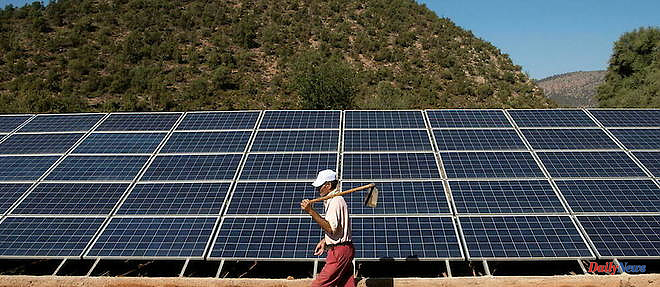Appointment was given in Aix-en-Provence on May 3. A short chemistry lesson and big scientific discussions to restore the current state of science and research on a complex subject: hydrogen, this energy which could become an alternative green energy source. "Hydrogen tomorrow: myths and realities" was therefore the subject of this 13th edition of the Round Tables of Arbois and the Mediterranean, which organize each year a two-day conference around scientists and experts in the large amphitheater of the Faculty of Law of Aix-en-Provence. The objective is to disseminate scientific knowledge, to inform, to debate and to give citizens the keys to understanding the major current issues.
“The world as we would like it can only exist if the energy options of the 21st century are respectful of the commons and accessible to the poorest. The hydrogen vector is a promise for obtaining such energy, "says the professor and founder of this event, Daniel Nahon.
"This subject has been brought back to the forefront with the war in Ukraine, the increase in the price of energy, especially gas, as well as the increasingly tangible climate crisis", recalls Fahd Benkirane, director for France from the Mohammed-VI Polytechnic University, at the opening of the conference. “Hydrogen enjoys unprecedented temporal relevance, as it offers a glimmer of hope in solving economic and environmental issues. Harnessing excess renewable energy capacity to create hydrogen is a virtuous circle in the quest for greener and more sustainable human growth,” he continues.
However, hydrogen is not a recent discovery. Jules Verne, a novelist of visionary anticipation, described it in his novel The Mysterious Island in 1875. "Yes, my friends, I believe that water will one day be used as fuel, that hydrogen and oxygen, which constitute it, used separately or simultaneously, will provide an inexhaustible source of heat and light and of an intensity that coal cannot have", he had one of his characters say. Daniel Nahon also recalls that hydrogen is the fuel used in rocket propulsion and that its energy capacity is greater than all other fuels.
In nature, hydrogen is associated with other elements, carbon to form methane and oxygen to form water. For example, the chemistry formula for water (H2O) is made up of hydrogen (H2) and oxygen (O). To isolate hydrogen, it must therefore be separated from the other elements.
To date, more than 90% of hydrogen production is achieved by gasification from fossil fuels. But the objective and the urgency are indeed to develop the production of hydrogen from the electrolysis of water, via a renewable energy, which makes it possible to separate the elements - oxygen and hydrogen - and to produce hydrogen decarbonized, or green. And conversely, in the process, if we mix hydrogen with oxygen through the use of a fuel cell, we will be able to produce electricity. "This carbon-free hydrogen will certainly play a very important role in the energy transition", anticipates Abdelilah Slaoui, research director at the CNRS, responsible for the energy cell.
The hydrogen produced today is mainly used for the manufacture of ammonia, the raw material that makes up fertilizers, and for the refining of petroleum products, in order to desulphurize fuels. Worldwide, nearly 60 million tons of hydrogen are produced per year.
“Hydrogen is not an energy in itself, but an energy carrier. Once produced, it has to be stored, transported and used,” explains Abdelilah Slaoui. The potential uses are many. Already, 600 Parisian taxis run on hydrogen. The technology can be adapted to trucks, trains, ships and tomorrow to planes. In the heavy industry sector, researchers imagine it as a replacement for fossil fuels, particularly for steel and cement.
For all these potential applications, the major challenges for researchers remain to improve performance, reduce costs and the durability of hydrogen production, storage and transport systems.
All agree to mention the enormous potential of the African continent in natural resources. “Solar, wind, but also hydro – for example, the Democratic Republic of Congo has enormous potential – to make hydrogen, not to mention biomass. All of these renewable energy resources can be harnessed for electrification and hydrogen production,” comments Paul Duchesse, Chairman of the International Energy Agency (IEA) Hydrogen Accord. “Africa should step up. Each country has its energy genius. Solar and wind power for Morocco and Mauritania, wood waste in Gabon, but also geothermal energy for Djibouti. In Mali, there is even white hydrogen, natural hydrogen,” says Marc Guillaume, professor at Polytechnique.
Green hydrogen production in Africa is expected to reach 50 million tonnes per year by 2035, according to a report by the European Investment Bank, the International Solar Alliance and the African Union, published last November: " Africa's Extraordinary Green Hydrogen Potential”. The analysis highlights the benefits of harnessing solar energy to create green hydrogen in four African hubs: Mauritania, Morocco, Southern Africa and Egypt. “Economically viable at €2/kg, green hydrogen can accelerate low-carbon economic growth across the continent and reduce emissions by 40%,” according to the report.
“Africa also has significant mineral resources for the energy transition. The DRC is home to the largest cobalt reserves, although exploitation is subject to much controversy. If the context is there, a stable political framework is needed for manufacturers and investors to have confidence. Not all countries are in the same boat,” observes Paul Duchesse.
Mauritania is always cited for its extraordinary potential. "It has iron ores, a lot of wind and sun, nothing prohibits, to install iron and steel industries so that the country, which has a small population, exports decarbonized steel", he continues.
"In Morocco, the foundations of energy sovereignty are there. The Noor Ouarzazate complex houses one of the largest solar power plants in the world. With such momentum, our goal of 52% renewable energy by 2030, including green hydrogen is within reach,” says Fahd Benkirane.
The first objective is to produce green ammonia. For the Moroccan group, OCP, which produces fertilizers, the aim is to gradually replace ammonia imports with ammonia produced on site from renewable energies. To do this, OCP in partnership with Mohammed VI Polytechnic University (UM6P) is accelerating research in this area.
“Our ambition is to make Morocco a world leader in the industrialization and development of green hydrogen. UM6P continues to establish strategic partnerships at the national and international level, in particular with the installation of green ammonia pilot projects in the facilities of the OCP group, with a view to industrialization on a larger scale", comments Fahd Benkirane .
"Africa can secure access to clean and sustainable energy on the continent and become a global energy player through green hydrogen exports," says the Africa Green Hydrogen Report which also assesses investments needed at 1,000 billion euros. Maybe… but before exporting green hydrogen, shouldn't Africa already light up, use this energy to develop? “Namibia is the subject of a lot of attention from Germany,” notes Paul Duchess, who acknowledges that “very critical reports from NGOs have been published on this German policy”. For his part, Marc Guillaume insists: “Africans must take the initiative, rely on small projects that can grow. For very big projects, like those emerging in Mauritania, "it's up to African countries to be in the negotiation, to play the competition between Germany, Great Britain, Japan...".
To conclude in an optimistic way these two days of round tables, Hicham El Habti president of the IM6P affirms that "Africa is so generous that it will contribute to the decarbonization of the world economy".












